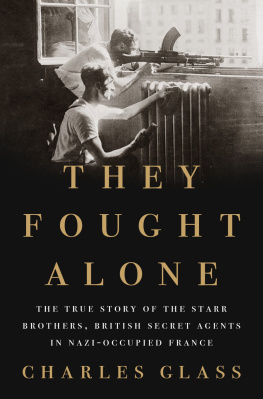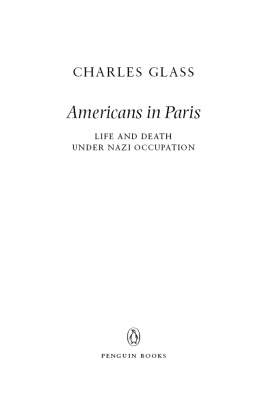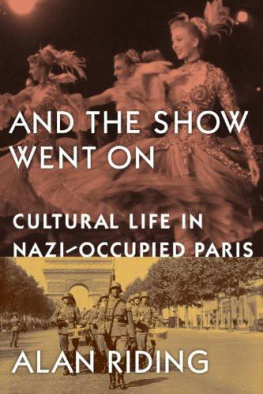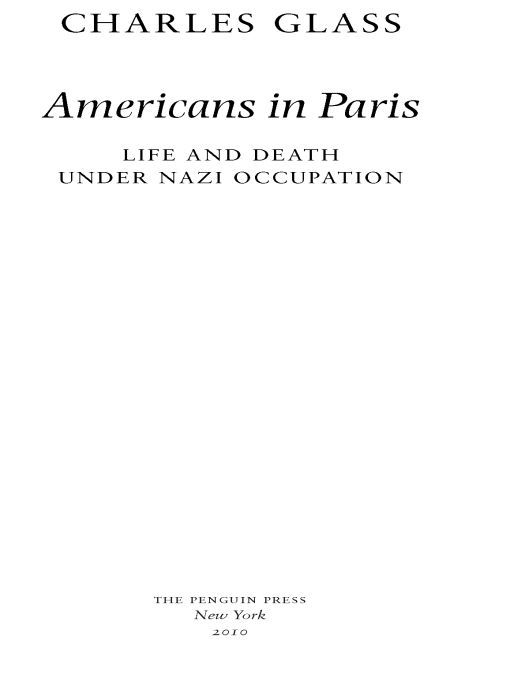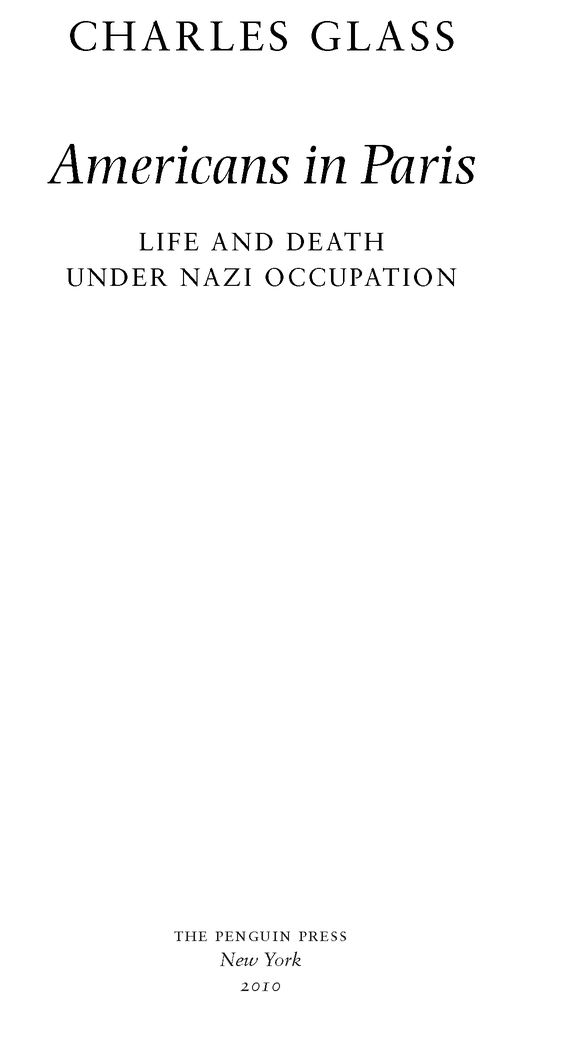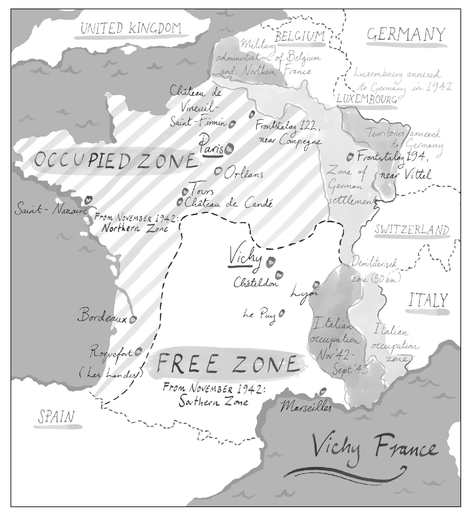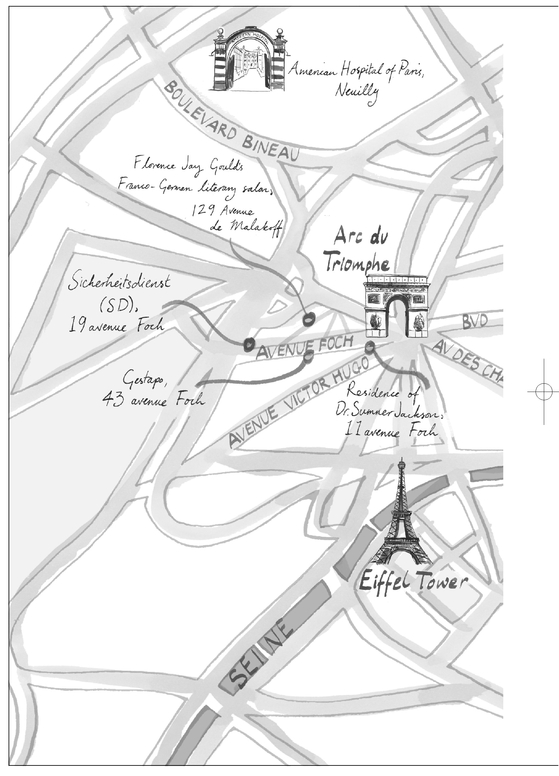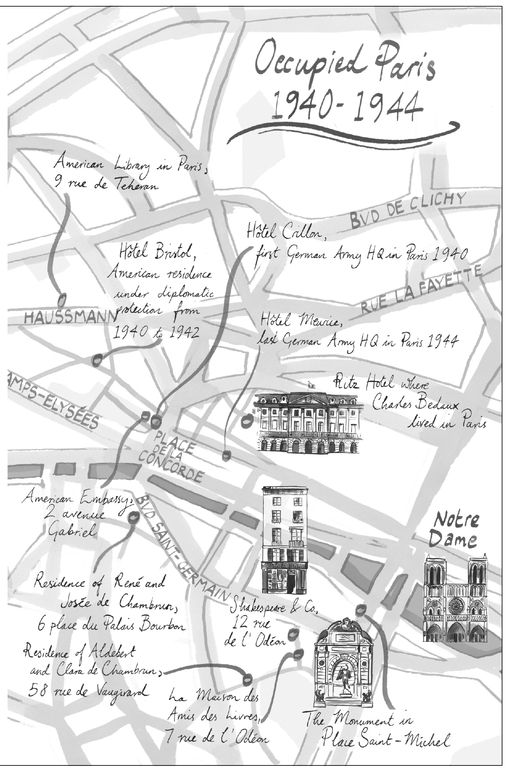Table of Contents
By the same author
Tribes with Flags
Money for Old Rope
The Northern Front
The Tribes Triumphant
To the memory and glorious spirit of Charles Glass, Jr., my father and unwavering partisan, born 11 October, 1920, died 2 February, 2008.
LIST OF ILLUSTRATIONS
The author and publisher are grateful to the following for permission to reproduce their copyright material. While every effort has been made to trace the owners of copyright material reproduced herein, the publishers would like to apologise for any omissions and will be pleased to incorporate missing acknowledgements in any future editions.
SECTION I
Josephine Baker. (Roger-Viollet/TopFoto)
William C. Bullitt. (Roger-Viollet/TopFoto)
Roosevelt, Marguerite LeHand and William C. Bullitt. (Image credited to World Wide Photos in For the President: Personal & Secret by Orville H. Bullitt (ed), Houghton Mifflin, Boston, 1972)
Myrsine and Helene Moschos and Sylvia Beach next to Ernest Hemingway, outside Shakespeare and Co. (Image credited to Princeton University Library in Sylvia Beach and the Lost Generation by Noel Riley Fitch, W. W. Norton, New York, 1983)
James Joyce, Sylvia Beach and Adrienne Monnier in Shakespeare and Co. (Gisele Freund/Time & Life Pictures/Getty Images)
Sylvia Beach in Shakespeare and Co. ( Bettmann/CORBIS)
Sylvia Beach decorates the bookshops window. ( Bettmann/CORBIS)
Adrienne Monnier in La Maison des Amis des Livres. (Roger-Viollet/TopFoto)
Clara Longworth de Chambrun. (Photograph by Rogi-Andre in Shadows Lengthen by Clara Longworth de Chambrum, Scribner, New York, 1949)
Clara fought to keep the library open throughout the occupation. (Courtesy of The American Library in Paris)
An information card for the American Library. (Courtesy of The American Library in Paris)
Jose Laval and Ren Chambrun. ( Topfoto)
Claras house. (In Shadows Lengthen by Clara Longworth de Chambrum, Scribner, New York, 1949)
Pierre Laval leaving the Chteau de Chteldon. (Roger-Viollet/TopFoto)
Charles Bedaux and his wife, Fern, in South Africa. (In The Price of Power by Jim Christy, Doubleday and Company Inc., New York, 1984)
Charles and Fern Bedaux. (Bettman/CORBIS)
J. Edgar Hoover. (MPI/Getty Images)
Charles Bedauxs country residence, the Chteau de Cand. ( Cond Nast Archive/CORBIS)
Dr Sumner Jackson with his son, Phillip. (Courtesy of Phillip Jackson)
SD Major-General Karl Oberg. ( Rue des Archives/Tal)
Dr Edmund Gros. (Courtesy of The American Hospital of Paris)
SECTION II
Dr Sumner Jackson, Dr Thierry Martel, Dr Edmund Gros and Toquette. (Courtesy of The American Hospital of Paris)
The entrance to the American Hospital in Neuilly. (Time & Life Pictures/Getty Images)
Drue Leyton. (Otto Dyar/General Photographic Agency/Getty Images)
Florence Jay Gould. ( Fonds Foundation Florence Gould in Florence Gould by Gilles Cornut-Gentille and Phillipe Michel-Thiriet, Mercure de France, Paris, 1989)
Polly Peabody. (In Occupied Territory by Polly Peabody, The Cresst Press, London, 1941)
General Otto von Stlpnagel. (Roger-Viollet/TopFoto)
Karl-Heinrich von Stlpnagel. (akg-images/ullstein bild)
A German military parade passes the Htel de Crillon. (RDA/Tallandier/Archive Photos/Getty Images)
Paris under occupation outside the Htel Meurice. (Roger-Viollet /TopFoto)
Marshal Ptain, pictured with his cabinet. (akg-images)
Marshal Ptain with American Ambassador to Vichy, Admiral William D. Leahy. (akg-images)
Shakespeares King John. (In Shadows Lengthen by Clara Longworth de Chambrum, Scribner, New York, 1949)
Parisians welcome an Allied tank. (RDA/Getty Images)
American flags on the Champs-Elyses. (Roger Viollet/Getty Images)
Ernest Hemingway in Sylvia Beachs flat. (Princeton University Library)
Phillip Pete Jackson. (Courtesy of Phillip Jackson)
Charlotte Toquette Jackson. (Courtesy of Phillip Jackson)
INTRODUCTION
IN THE PLAZA WHERE THE Boulevard Saint-Michel approaches the River Seine, water cascades down stone blocks of a vast monumental tribute to those who endured the four-year German occupation of Paris. The Archangel Michael stands guard above an old memorial that was rededicated after the Second World War, above all, to the civilians killed nearby when the people of Paris finally rose against their oppressors in the summer of 1944. Reading the inscriptions and looking at the stone lions beside the shallow pool, I used to imagine life during the fifty months from 14 June 1940, when the Germans marched proudly into Paris, and 25 August 1944, when they retreated in shame. I wondered how I would have behaved while the Wehrmacht ruled the cultural capital of Europe. Many books and films on the period depicted French behaviour that varied from self-sacrifice and heroism to treason and complicity in genocide. But what would I, as an American, have done? Was it possible to survive until liberation day, 26 August 1944, without compromising or collaborating? Would I have risked my life, or the lives of my family, by fighting for the Resistance? Or would I have waited patiently with the majority of Parisians for the German retreat?
Nearly 30,000 Americans lived in or near Paris before the Second World War. Those who refused to leave were, paraphrasing Dickens, the best and the worst of America. Like the French, some collaborated, others resisted. The Germans forced some into slave labour. At least one was taken back to the United States to face a trial for treason. Americans in Paris under the occupation were among the most eccentric, original and disparate collection of their countrymen anywheretested as few others have been before or since. This is their story.
When Britain and France declared war on Germany for invading Poland in September 1939, American Ambassador William Bullitt advised United States citizens without vital business to leave France immediately. At least 5,000 ignored him and stayed. While many had professional and family ties to Paris, the majority had a peculiarly American love for the city that had its origins in the debt the young United States owed to the Frenchmen who volunteered with the Marquis de Lafayette to fight for American independence after 1776. The American love affair with Paris, where the United States opened its first diplomatic mission, was shared by Benjamin Franklin, John Adams (whose wife, Abigail, famously said, No one leaves Paris without a feeling of


